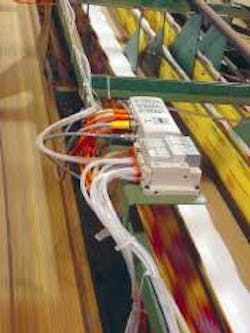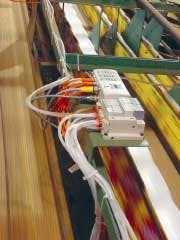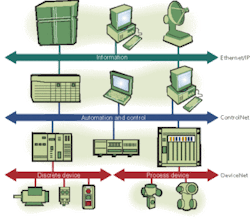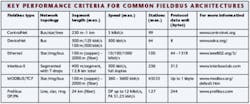Real-time networks support vision
Networks such as DeviceNet, ControlNet, Ethernet/IP, and MODBUS/TCP integrate imaging and process-control systems.
By R. Winn Hardin, Contributing Editor
During the past few years, machine-vision companies have leveraged Ethernet/LAN technologies to enhance performance of their systems. High-bandwidth Ethernet connections have meant that vision systems could do more than transmit "pass/fail" results. Ethernet protocols with 10/100/1000-Mbit/s bandwidths have allowed vision systems to archive images for later evaluation by plant engineers and store inspection criteria on a per-part basis to meet customer quality specifications in industries such as electronics, medical devices, and pharmaceuticals.
As these systems have become a more intrinsic part of manufacturing practices—becoming just another component in a closed-loop process-control system—customers are asking for systems that are compatible with real-time Fieldbus networks. These networks include DeviceNet, ControlNet, a variety of Ethernet protocols, MODBUS/TCP, Foundation Fieldbus, FieldPoint, control-area networks (CANs), ASi-Bus, InterBus, and Profibus. Fieldbus architectures differ in communication interfaces, application layers, bandwidth, and other criteria; however, one of the major differentiating factors in choosing a Fieldbus is simple geography. DeviceNet, ControlNet, Ethernet/IP, Fieldbus Foundation, FieldPoint, and MODBUS/TCP were created by PLC companies based in the USA—Allen-Bradley, National Instruments (NI), and Modicon (now Schneider Electric). CAN, ASi-BUS, InterBus, and Profibus were created by European and Asian groups. The four architectures mainly used in North American manufacturing operations are DeviceNet, ControlNet, Ethernet/IP, and MODBUS/TCP (see Fig. 1).
"OPEN" ARCHITECTURES
Although each of these Fieldbus architectures is an "open" standard, this does not mean that a piece of hardware or software from one standard can communicate with hardware/software from another standard. In fact, "open" means different things to different standards.
Standard Ethernet or TCP/IP protocol is the best example of an open standard. Ethernet includes a communication protocol developed by an independent body, the IEEE, which has led to an architecture that is unfettered by a proprietary application layer. Users do not have to pay a licensing fee to use the Ethernet protocol, which encourages development of Ethernet hardware, resulting in significantly lower cost for Ethernet hardware compared with many high-bandwidth Fieldbus architectures. (However, industrialized Ethernet boards do cost significantly more than standard consumer Ethernet hardware.)
"In the past three or four years, there is has been an increasing need for connectivity, usually for reporting requirements and SPC [statistical process control] analysis," notes Art Gaffin, founder and president of Sightech Vision Systems. "Traditionally, machine-vision systems have been isolated—you bolt them on the line, they inspect something, and they tell a PLC to eject a part. That's about 80% to 90% of vision systems. Ethernet is the dominant network now because it uses off-the-shelf components. After all, a lot of applications only need an inspection once every few seconds, so Ethernet is fine."
When real time is an issue, however, and parts are moving too fast for excessive latency in an Ethernet-based network, there are other alternatives. DeviceNet and ControlNet precisely define I/O scan or transmission schedules to minimize latency between transmissions. However, PLCs running on these networks have very little processing capability and no overhead for routing signals, unlike Ethernet variants such as Ethernet, Ethernet/IP, or MODBUS/TCP. These two factors—latency and lack of internal processing—have led automation networks to include an application layer in addition to the communication protocol, resulting in a variety of semi-open/semi-proprietary Fieldbus architectures.
PPT Vision application engineering manager Jeff Banister believes that after Ethernet variants based on the IEEE 802 protocol, MODBUS/TCP is the most open architecture because the software does not require a licensing fee, and MODBUS/TCP uses standard Ethernet hardware. Allen-Bradley's Ethernet/IP solution comes in second on the open-architecture rating standard because, while vision-system suppliers can use standard Ethernet cards to communicate with an Ethernet/IP plant network, the integrator has to pay a one-time fee for Allen-Bradley's Ethernet/IP standard before integrating it into the system. ControlNet and DeviceNet both require the vision supplier to purchase hardware and software specific to that network (see Fig. 2).
ON THE NETWORK
Between 5% and 10% of customers ask designers to integrate a vision system with a Fieldbus network, excluding standard Ethernet/LAN networks. "This is mostly because machine vision does not require vast amounts of real-time I/O, and, therefore, the benefits of Fieldbuses are often not justified," says PPT Vision vice president of marketing Joe Rogers.
Says Anish Mathews, project manager at Soliton Technologies, within this growing niche of applications, most vision systems communicate with nearby PLCs or NI FieldPoint devices using either one or a combination of Ethernet, RS-232/RS-485, CAN, and DeviceNet, and/or through digital handshakes using hardwired relays. "The PLCs and FieldPoint devices typically come into play for material handling and automation for closed-loop control," Mathews explains. "However, the most preferred mode for communicating with information management assets for data storage, reporting, and so forth, is Ethernet."
Although PPT Vision's Banister concedes that RS-232 connecting directly to PLC is a common method for point-to-point communications with a PLC, he cautions that RS-232 connections require some programming to parse the data so that the PLC can understand and properly route it, "whereas a Fieldbus is mapping I/O from one point to another workspace." RS-232 cable runs also are limited to 50 ft without a repeater, although Sightech's Gaffin notes that most vision systems are located next to the PLC, and so distance is usually not the guiding factor.
While distance may not be a common driver to integration, it does come into play when the plant is using remote cameras or distributed embedded or dedicated vision systems, also called smart cameras. In one ball-grid-array inspection application, PPT Vision included an Allen-Bradley DeviceNet I/O card with its vision system so that pass/fail signals could be sent across the DeviceNet network, rather than running a separate cable. "DeviceNet is a real-time network for process control, whereas other methods of data collection are not," Banister says. Users should understand, however, that each Fieldbus architecture has its own physical limits, typically based on storage capacity, transmission speed, and whether copper or optical fiber is used (see Fig. 3).
Remote access and data archival can be handled by any of the Fieldbus architectures, depending on how much bandwidth is required for the application, distance, and so forth. Typically, larger image files will necessitate an Ethernet variant, although image data are not stored locally on PLCs, but rather on remote PCs or servers, because of memory constraints on the PLC. When report data from the vision system do not include images, adds Sightech's Gaffin, some clients prefer data to be stored on local PLCs, which can be fed by a low-bandwidth Fieldbus architecture in addition to Ethernet variants.
ControlNet's 5-Mbit/s transmission speed offers a compromise between Ethernet variants and DeviceNet's maximum 500-kbit/s transmission (see table). For one automotive-inspection application, describes PPT Vision's Rogers, the company used a ControlNet hardware bridge to connect a vision system to the existing ControlNet infrastructure so "that our vision system was consistent with the other products in the plant, making usability easier for maintenance and plant personnel."
PLANNING FOR GROWTH
Fieldbus architectures that embed network data in an Ethernet/TCP/IP packet have an inherent advantage in speed over proprietary Fieldbus architectures because Ethernet-based architectures utilize commercial hardware that benefits from increasingly faster and cheaper electronics. Another important factor when considering Fieldbus architectures is how the device configuration is stored and updated on the automation network. For example, Allen-Bradley's Fieldbus architectures use electronic data sheets (EDSs) stored on the PLC. These EDS files describe the system hardware configuration and how the data are used by the PLC at the other end.
Vision-system suppliers or integrators typically provide a generic EDS based on the system hardware or a modified EDS file based on the most common vision applications. For example, EDS files can be used to control a vision system across an Allen- Bradley plant network. However, if the variety of parts under inspection changes, or the type of inspection changes, the end user will have to get a new EDS file from the supplier or integrator.
Despite the variety of bus architectures and matrix of performance specifications, system integrators must work within Fieldbus networks. "When you're dealing with real-time data, a Fieldbus is a fast way to get the data from one process to another," concludes PPT Vision's Banister.
Company Info
Allen-Bradley Rockwell Automation, Milwaukee, WI, USA www.ab.com
National Instruments, Austin, TX, USA www.ni.com
PPT Vision, Eden Prairie, MN, USA www.pptvision.com
Schneider Electric USA, Palatine, IL, USA www.us.scheider-electric.com
Sightech Vision Systems, San Jose, CA, USA www.sightech.com
Soliton Technologies, Brookfield, WI, USA www.solitontech.com




